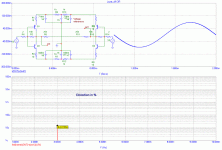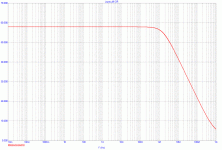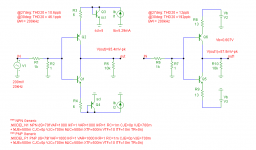PMA, I thank you very much, but I think that we have hit the end of the line. I will not put forth anything directly that is less than 30 years old on this website, but it has been fun to see these models of topology idealized. I personally don't see the point in giving any more real information to this general group of people. Feel free to contact me directly or through this thread, but I have run out of steam. Thanks again for your great modeling, I wish I could share more sophisticated topologies here, but I just can't afford to.
John -
thank you very much. I have been aware of this what you are saying, I have been aware of possible inconveniences resulting from evolution of your hints. It has been great to co-operate with such GREAT designer as you are.
Thanks again,
Pavel
thank you very much. I have been aware of this what you are saying, I have been aware of possible inconveniences resulting from evolution of your hints. It has been great to co-operate with such GREAT designer as you are.
Thanks again,
Pavel
john curl said:PMA, I thank you very much, but I think that we have hit the end of the line. ............
Hi John,
The end of the line? I don't think so. The biggest challenge is how to realize the correct bias currents.
@Pavel
In the virtual world of MC, the voltage sources V5----V8 are easily implemented. But would you do that in real life?
How to address issues like noise, internal resistance, and (maybe even more important) temperature compensation.
See also: http://www.diyaudio.com/forums/showthread.php?postid=1490431#post1490431
Cheers,
Edmond.
PS: Is this input"'technical" enough?
Hi Edmond,
yes, this is the perfect input of yours, but I would follow John's wish and not going to evolve this idea anymore. It was not my circuit idea in the beginning.
Regards,
Pavel
yes, this is the perfect input of yours, but I would follow John's wish and not going to evolve this idea anymore. It was not my circuit idea in the beginning.
Regards,
Pavel
I think Carver adjusted the Zout of his amp to make it indistinguisable (in sound) from a specific tube amp. Successfully.
How was success determined? Was it scientifically or subjectively determined? If it was not by scientific method then that little story of common knowledge must be refered to the dustbin.
Bas Horneman said:
How was success determined? Was it scientifically or subjectively determined? If it was not by scientific method then that little story of common knowledge must be refered to the dustbin.
Bas,
According to this post there was at least one single blind test.
I like that guy: first building an all-out, no-holds-barred super-expensive amp, then built one that sounds the same but goes for 1/40 of the price...
Jan Didden
From the Polk Audio ste: (don't know how accurate this is):
"Yes Bruce. After "The Great Amplifier Challenge" in Santa Fe, the Stereophile guys just couldn't give him the credit he had just earned in the motel room they paid for. Three things came out of the challenge:
1. He absolutely with no questions asked, met all the parameters he and Stereophile had set forth. In 48 hours, in a motel room, he made his solid-state, $629 retail amp sound EXACTLY like a pair of Conrad-Johnson Premier 5's. Stereophile admitted it. In fact, after 24 hours, his amp sounded exactly like the C-J's, except the low-end wasn't as "muddy" as the C-J's. Those were Stereophiles words. "Yours has better, tighter bass" were also Stereophiles words. So he sent them home, "muddied" up the low-end on his amp, called them back, and Stereophile threw in the towel.
2. It was reported in Stereophile that he "won", but they just HAD to add that they didn't THINK he could keep up the QC on a factory assembly line.
3. They also said, "If he's SOOOOO good, why doesn't he design his OWN reference amp instead of emulating the sound of everbody elses?"
That pissed him off enough to design the Silver Seven's. I don't recall if Stereophile ever reviewed it, but The Absolute Sound did, and they indicated it was in fact, maybe the best amp ever built.
Every SS amp he designed after that was "transfer function modified" to emulate the sound of the Silver Sevens.
That run started with the M4.0t, and included the TFM series (I don't think the TFM-6 or TFM-15 are included) of amps. TFM-24/25, TFM-35, TFM-42/45, TFM-55, and TFM-75. Naturally the TFM standing for transfer function modified.
I know he didn't produce a lot of Silver Seven's, and I'd venture 1,000 was about right.
George Grand (of the Jersey Grands)"
Edit: The real thing: http://www.carveraudio.com/CarverChallenge.pdf
Jan Didden
"Yes Bruce. After "The Great Amplifier Challenge" in Santa Fe, the Stereophile guys just couldn't give him the credit he had just earned in the motel room they paid for. Three things came out of the challenge:
1. He absolutely with no questions asked, met all the parameters he and Stereophile had set forth. In 48 hours, in a motel room, he made his solid-state, $629 retail amp sound EXACTLY like a pair of Conrad-Johnson Premier 5's. Stereophile admitted it. In fact, after 24 hours, his amp sounded exactly like the C-J's, except the low-end wasn't as "muddy" as the C-J's. Those were Stereophiles words. "Yours has better, tighter bass" were also Stereophiles words. So he sent them home, "muddied" up the low-end on his amp, called them back, and Stereophile threw in the towel.
2. It was reported in Stereophile that he "won", but they just HAD to add that they didn't THINK he could keep up the QC on a factory assembly line.
3. They also said, "If he's SOOOOO good, why doesn't he design his OWN reference amp instead of emulating the sound of everbody elses?"
That pissed him off enough to design the Silver Seven's. I don't recall if Stereophile ever reviewed it, but The Absolute Sound did, and they indicated it was in fact, maybe the best amp ever built.
Every SS amp he designed after that was "transfer function modified" to emulate the sound of the Silver Sevens.
That run started with the M4.0t, and included the TFM series (I don't think the TFM-6 or TFM-15 are included) of amps. TFM-24/25, TFM-35, TFM-42/45, TFM-55, and TFM-75. Naturally the TFM standing for transfer function modified.
I know he didn't produce a lot of Silver Seven's, and I'd venture 1,000 was about right.
George Grand (of the Jersey Grands)"
Edit: The real thing: http://www.carveraudio.com/CarverChallenge.pdf
Jan Didden
An impressive feat by Bob. But maybe the test says a lot about the Stereophile reviewers as well. 😀According to this post there was at least one single blind test.
Bas Horneman said:
An impressive feat by Bob. But maybe the test says a lot about the Stereophile reviewers as well. 😀
In that case, we can dustbin all of Stereophile's tests as unreliable, right?
Jan Didden
Nah...I won't. I just read the actual article you posted.In that case, we can dustbin all of Stereophile's tests as unreliable, right?
The real thing: http://www.carveraudio.com/CarverChallenge.pdf
And the listening tests were not scientific at all. The thing is the Stereophile test was conducted in roughly the same way my audio buddies and I would do it. (And therefore I am convinced that Bob Carver did indeed win the challenge. And I've gained respect for Bob Carver which I lost when I read his article on toroidal vs EI transformers) [edit] because he seems to know a thing or two about amplifiers.
However it seems to me that all followers of the objective/scientific "community" cannot give one iota of creedence to the subjective judgement of the Stereophile test panel. And should classify it as anecdotal trash that does not prove a thing.
Wow, the part time wordsmiths, hired because they write entertaining prose rather than because of any actual expertise, produce reviews with no credibility. Hmph, what a surprise. Stereophile isn't a technical journal, it's a commercial magazine that provides entertainment.
OTOH, it was always interesting to see John Atkinson's measurements.
I have a very strong suspicion that there was far less to the transfer-function stuff than Carver let on. But it's all part of the show.
OTOH, it was always interesting to see John Atkinson's measurements.
I have a very strong suspicion that there was far less to the transfer-function stuff than Carver let on. But it's all part of the show.
Hi Pavel.
Back to technical input. As promised, I've fiddled a bit with the bias circuit. It is a first attempt, so it's not perfect, just an idea.
From the figure below, we can see that biasing with a constant voltage is very critical and that temperature has a profound effect on distortion (and gain!).
Biasing with scaled up (5X) trannies and currents sources makes the circuit far less temperature dependent, at least according to MicroCap.
Is it practical? I don't care, did it just for fun.
Cheers,
Edmond.
Back to technical input. As promised, I've fiddled a bit with the bias circuit. It is a first attempt, so it's not perfect, just an idea.
From the figure below, we can see that biasing with a constant voltage is very critical and that temperature has a profound effect on distortion (and gain!).
Biasing with scaled up (5X) trannies and currents sources makes the circuit far less temperature dependent, at least according to MicroCap.
Is it practical? I don't care, did it just for fun.
Cheers,
Edmond.
Attachments
There was a good reason why it was biased through resistors + big caps. There is a way how to find proper constant voltage biasing, however.
PMA said:There was a good reason why it was biased through resistors + big caps. There is a way how to find proper constant voltage biasing, however.
Hi Pavel,
A constant bias current is far from optimal. As you know, of course, for minimal distortion one should set RE = 0.5 * VT / Ie, where VT is the thermal voltage at room temperature (~26mV) and RE is the sum of the internal and external emitter resistance.
So, you need a current source which varies linear with the abs. temperature.
Cheers,
Edmond.
john curl said:A mercury battery will satisfy the requirement. With added return caps.
Hi John,
I thought you doesn't like caps in the signal path, especially electrolytic ones. And a 10000uF polystyrene cap isn't an option ether.
Cheers,
Edmond.
- Status
- Not open for further replies.
- Home
- Amplifiers
- Solid State
- John Curl's Blowtorch preamplifier


